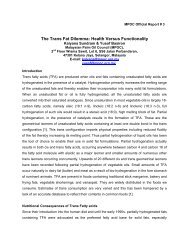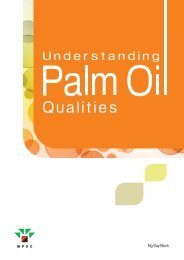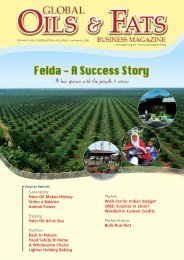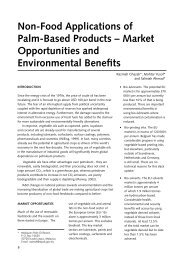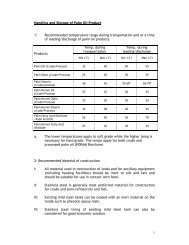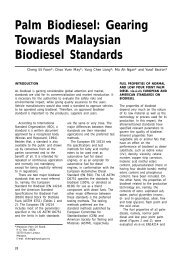Create successful ePaper yourself
Turn your PDF publications into a flip-book with our unique Google optimized e-Paper software.
Bullish on CPO<br />
We remain bullish on CPO prices for four<br />
reasons: rising crude oil prices have spurred<br />
the use of CPO as a bio-fuel; the substitution<br />
effect; Malaysia’s bio-fuel policy; and biodiesel<br />
exports to the rest of Asia Pacific.<br />
Crude oil prices have hit historical highs<br />
of over US$70 per barrel. The economics<br />
make sense to utilise palm oil whenever<br />
possible, for example in stationary engines<br />
such as power generators and power<br />
plants. In short, if crude oil prices remain<br />
high, then governments will expedite<br />
renewable energy plans to diversify their<br />
fuel sources.<br />
In addition to the potential of bio-diesel<br />
in the EU, there is growing demand for<br />
bio-energy (bio-fuel for power plants),<br />
which is relatively unknown within the<br />
investment community. As underlined in<br />
the Commission’s Green Paper on<br />
Security of Energy Supply, the EU’s<br />
objective is to reach a share of 12%<br />
(including wind, solar, hydro, biomass<br />
and bio-diesel) for the contribution of<br />
renewable energy sources to the EU’s<br />
gross inland consumption by 2010.<br />
To reach this target, major legislative<br />
proposals have been adopted. The<br />
‘Directive on Renewable Energies’<br />
adopted in 2001 provides for an overall<br />
EU indicative target of 22% by 2010,<br />
from the current level of<br />
about 14%, for the share of renewable<br />
energy sources of the EU’s electricity<br />
consumption. The directives allow<br />
member-countries to decide how to<br />
achieve the indicative national targets.<br />
The main drivers include the move to<br />
reduce carbon dioxide emissions, enhance<br />
sustainability, reduce the EU’s<br />
dependence on imported energy sources<br />
and increase diversification of fuel<br />
supplies.<br />
This suggests that the potential market for<br />
biomass (including vegetable oils) is 130<br />
million tonnes per annum. Subsidies will<br />
help in making palm-based fuel for bioenergy<br />
commercially viable. The subsidies<br />
differ for every EU country and can be as<br />
high as 200% of electricity prices and<br />
fixed for as long as 10-20 years.<br />
As palm-based bio-diesel is not significant<br />
at the moment, we believe that the sharp<br />
19% jump in CPO exports to the EU in<br />
2005 was actually channelled into the<br />
bio-energy sector. Some 600,000-<br />
750,000 tonnes of CPO were used in the<br />
renewable energy sector in 2005. Industry<br />
experts believe that this figure will grow to<br />
1 million tonnes in 2007.<br />
GLOBAL OILS & FATS BUSINESS MAGAZINE •VOL.3 ISSUE 3, 2006 7



